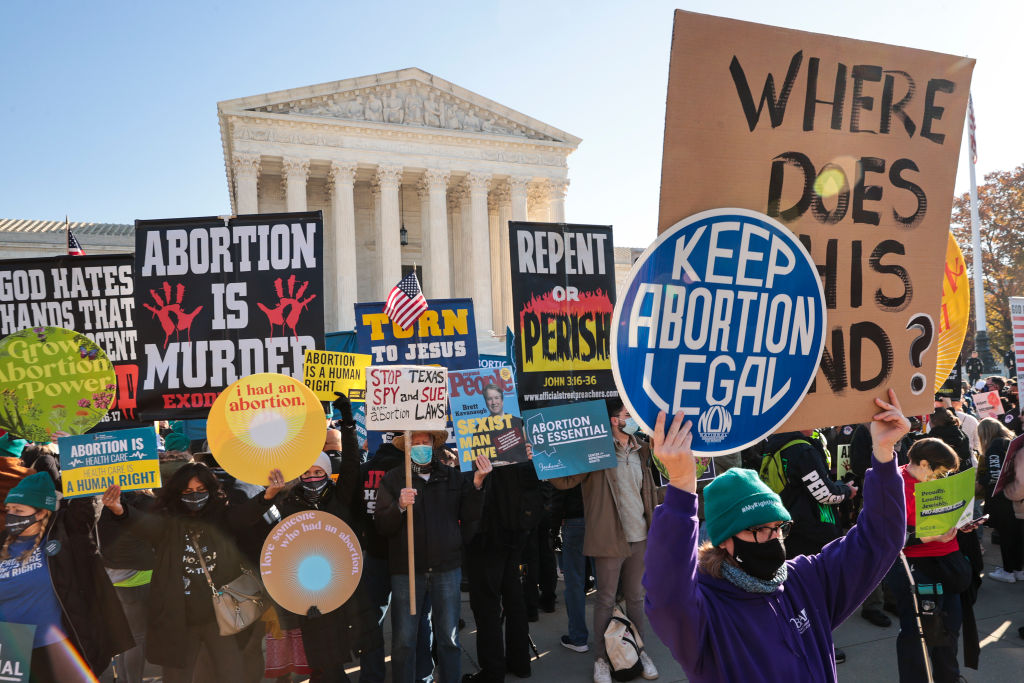In the two-plus years since Roe’s demise, the antiabortion movement and the Republican Party have been busy. Here’s where they’ve dedicated their time and resources—and where they haven’t.

This story originally appeared on Jill.substack.com, a newsletter from journalist, lawyer and author Jill Filipovic.
When the U.S. Supreme Court issued its ruling in Dobbs v. Jackson Women’s Health and overturned Roe v. Wade, there was a lot of talk—mostly from “compassionate conservative” abortion opponents—about what was next.
It would be necessary, these abortion opponents argued, for the ‘pro-life’ movement and perhaps even the Republican Party to finally turn its focus to actually helping women and babies. The country would be remade into one reflecting a broader “culture of life.” We were going to get a bipartisan pro-family agenda. Abortion wouldn’t just become illegal; the nation would be so welcoming to pregnant women that abortion would simply be unthinkable.
None of that has happened.
What the Antiabortion Movement Has Done
In the two-plus years since Roe’s demise, the antiabortion movement and the Republican Party have been busy.
They have outlawed nearly all abortions in 18 states, banned many abortions in several more, and penned and proposed abortion bans in more still.
They have spent vast sums litigating abortion bans. Several Republican attorneys general used their positions to support a case conceived by antiabortion groups and helmed by antiabortion doctors that sought to ban mifepristone, an abortion-inducing drug; even after those abortion opponents lost in the Supreme Court, the attorneys general of Idaho, Kansas and Missouri are pushing on, using tax dollars and state resources to ban mifepristone not just in their own states, but for all American women. In Indiana, Attorney General Todd Rokita just dropped his lawsuit against a doctor who performed an entirely legal abortion for a 10-year-old rape victim. The doctor spoke about the procedure in general terms that did not identify the patient, so the antiabortion movement accused her of lying (she wasn’t). Much of the media also cast doubt on her story, and when it turned out her story was true, Rokita sued her for allegedly violating patient privacy. This all happened in 2022; the meritless case was only dropped this summer.
Doctors clearly fear being prosecuted, because the language of these bans is so divorced from medical reality.
Since 2022, more than 100 pregnant women have been turned away from emergency rooms despite being in medical distress, according to an AP investigation. At least four women whose pregnancies were ectopic were denied care, despite the dangerous emergency nature of ectopic pregnancies. Two of those women were in Texas, where abortion is banned, and one lost her fallopian tube and part of her fertility as a result of the care she was denied—after nearly dying because her tube ruptured.
The standard of care for ectopic pregnancies, which are very dangerous and can never turn into healthy pregnancies, is to offer the pregnant woman a shot of a drug that will safely dissolve the pregnancy and preserve her fertility. But this does not fit with the antiabortion claim that a fertilized egg is a “person” imbued with a full set of rights. And while abortion opponents claim that ectopic pregnancy treatment should be allowed even under restrictive abortion bans, one wonders exactly how that might work—and doctors clearly fear being prosecuted, because the language of these bans is so divorced from medical reality.
In Florida, a woman who was 15 weeks pregnant while the state had a ban in place, went to the ER because she was leaking fluid. Doctors found that she was miscarrying, and there was no amniotic fluid surrounding her fetus—meaning the pregnancy would not survive. They nevertheless sent her home without treatment. She miscarried in a public bathroom, and was so ill she had to be put on a ventilator and hospitalized for nearly a week.
In the months and now years after Roe, hospitals and other health centers have also been turning away pregnant women in violation of EMTALA, a federal law that requires emergency centers to treat any patient who walks through their doors regardless of their ability to pay; if they don’t have the capacity to treat the patient, they must stabilize them before transferring them.
But EMTALA has also been a lightning rod for abortion opponents. After Roe fell, the Biden administration issued a directive basically saying that EMTALA applied to pregnant patients and, as federal law, superseded abortion bans—so even if a state banned abortion, it still had to treat women who came into ERs in acute life- or health-threatening medical distress.
The antiabortion movement does not want to do this; they argue that a fetus and a pregnant woman should be treated as equals, so even if a pregnancy is doomed and is threatening a woman’s physical health, a doctor cannot perform an abortion if there is still a fetal heartbeat. This has led to all sorts of horrific outcomes, with women going into septic shock, women needing emergency hysterectomies, women in serious medical distress being helicoptered out of state for emergency care, and so on.
Still, antiabortion attorneys general fought the Biden administration all the way up to the Supreme Court to essentially argue that their abortion bans could violate EMTALA—that they could let pregnant women suffer and even lose major organs in the name of “life.”
This came after women did suffer, and some nearly died, and some lost major organs, because emergency centers violated EMTALA in states with abortion bans.
- A Texas woman who was nine months pregnant showed up to an emergency care center having contractions the week after the Supreme Court overturned Roe; the front desk turned her away after a doctor refused to see her.
- Another woman who was miscarrying was turned away from a different Texas hospital, and she ended up having a miscarriage in a lobby bathroom.
- A North Carolina woman was also refused adequate treatment at an emergency center, and en route to a hospital 45 minutes away, she had a stillbirth in her car.
Oh, and Texas has also banned birth control for minors unless they have their parents’ permission, a move that seems virtually guaranteed to drive up adolescent pregnancy and birth rates.
These are the outcomes the “pro-life” movement is fighting for. And I could write thousands and thousands more words on them, because there are just so many horror stories. But it’s worth looking instead at what the antiabortion movement hasn’t done in the two years it has known that abortion bans were pushing some women to the brink of death, and forcing thousands more into unwanted motherhood.
What the Antiabortion Movement Has Not Done
- No state that has banned abortion has expanded contraception access. Some, like Texas, have either limited it or attempted to limit it.
- No state that has banned abortion has managed, as far as I can tell, to reduce their infant or maternal mortality rates. Some, like Texas, have seen infant mortality rates go up. And antiabortion states already generally had higher infant and maternal mortality rates than more liberal ones.
- In Texas, where perhaps the highest number of women have been traumatized, hospitalized or nearly killed thanks to abortion bans, several abortion bans remain in place—and none have been revised to include exceptions for a pregnant woman’s health, for rape and incest, or for serious fetal anomalies. Texas Republicans and antiabortion leaders know their bans are causing vast suffering, and that doctors are afraid to practice medicine under threat of criminal penalties. Still: They refuse to revise the bans. This is a pattern repeated in just about every abortion-hostile state in the nation.
- Texas continues to refuse to expand Medicaid, a move that could have saved the lives of more than 2,000 Texans and brought more than $5 billion to struggling hospitals in Texas—many of which lack maternity wards and adequate care for pregnant women and newborns, and in turn fuel the state’s maternal and infant mortality crises. As the pandemic wound down, nearly 1.7 million Texans lost Medicaid coverage, in a state where criteria to be in the program was already so restrictive that “it mainly covers poor children, their mothers while pregnant and post partum, and disabled and senior adults,” according to the Texas Tribune.
- Texas isn’t alone. Ten states have refused to adopt Medicaid expansions, nearly every single one of them led by “pro-life” Republicans.
- Some 90,000 Texans who have applied in the state for SNAP—food benefits for needy families—are caught in a backlog, going hungry while their applications are being (very slowly) processed.
- Not a single state that has a post-Roe abortion ban in place has passed a mandatory paid parental leave policy. Every state with a paid family and medical leave law is also a state that protects abortion rights.
- Despite early promises to leave abortion to the states, antiabortion groups have not done so. They have pushed for federal abortion bans. And Republican politicians in antiabortion states have overwhelmingly tried to bar their own citizens from voting on abortion directly—where ballot measures on abortion rights have been proposed, Republicans and antiabortion groups have tried to radically restrict ballot measures.
- Antiabortion states have not expanded their social safety nets. States that ban abortion continue to have some of the worst welfare systems and stingiest supports for single moms.
- Idaho also found time to ban abortion—and to fail to pass a bill that would have extended Medicaid coverage for women through 12 months after having a baby. The federal government offered the state $36 million in childcare funding; “pro-life” Idaho, which spent state resources fighting the Biden administration on the directive that emergency rooms save pregnant women’s health, turned it out. And while the state used to have a Maternal Mortality Review Committee to look at why so many Idaho women die while pregnant, in childbirth, or in the postpartum period, the state allowed that committee to die after it passed its abortion ban.
Again, this is just a snippet of what “pro-life” states have not done in the more than two years they’ve had to foster a “culture of life.” It turns out that a culture of life is less about promoting or preserving life and health, or even caring for babies, and more about just flat-out forcing women into childbearing no matter the circumstances. The antiabortion movement’s resources are nearly all being put in this same direction: banning abortion nationwide, and also putting contraception and IVF on the chopping block.
There’s been nothing for babies, nothing for mothers, nothing for families. Just draconian bans and leave women constrained, hurt and sometimes close to death. That’s it. That’s the pro-life priority.
At Ms. magazine, our mission is to deliver facts about the feminist movement (and those who stand in its way) and foster informed discussions—not to tell you who to vote for or what to think. We believe in empowering our readers to form their own opinions based on reliable reporting. To continue providing you with independent feminist journalism, we rely on the generous support of our readers. Please consider making a tax-deductible donation today if you value the work we do and want to see it continue. Thank you for supporting women’s voices and rights.












